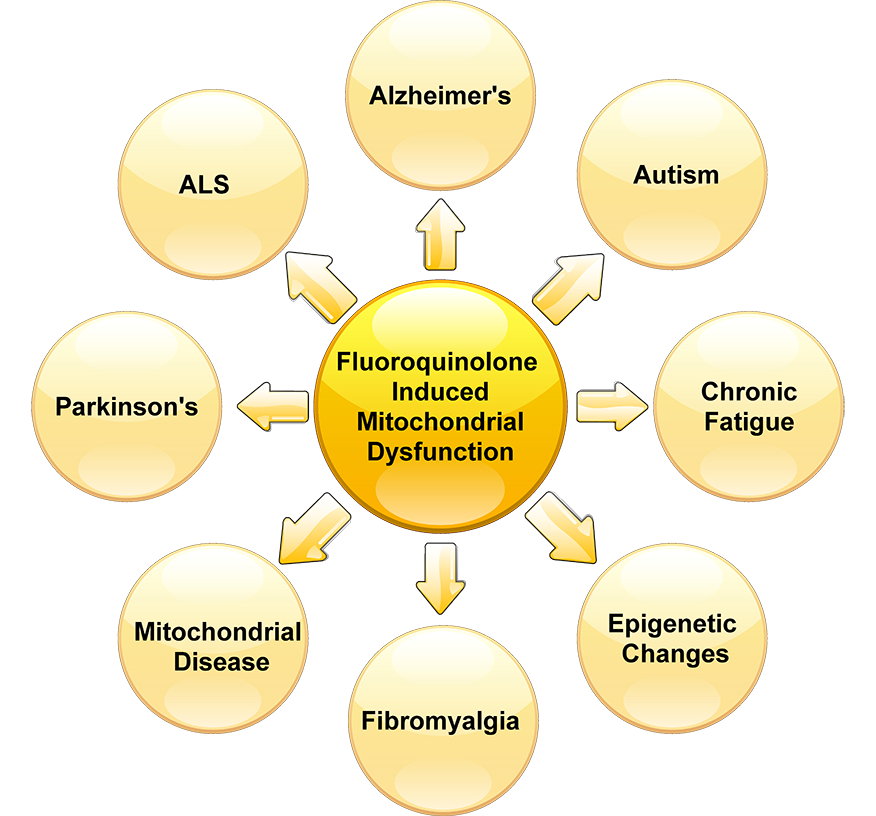
How do the fluoroquinolones cause pathogenic or disease processes?
They do it via Mitochondrial Dysfunction/Disease?
Fluoroquinolones Oxidative Stress Mitochondrial Dysfunction Disease Process
Click a circle on the wheel above to go to the respective page.
Background:
An internal FDA pharmacovigilance review memo dated April 17, 2013 on the Fluoroquinolones (FQs), issued by the Food and Drug Administration’s Center for Drug Evaluation and Research, Office of Surveillance and Epidemiology shows that the FDA is fully aware of permanent disabling health conditions in otherwise healthy individuals and that the likely method of action (or damage) is mitochondrial toxicity. They go on to note that the method of damage, mitochondrial toxicity, is also the underlying mechanisms in neurodegenerative diseases such as Parkinson’s, Alzheimer’s, and ALS (1).
More poignantly the FDA memo states “Fluoroquinolones act by inhibiting DNA gyrase and bacterial topoisomerase IV, both of which belong to the topoisomerase type IIA subfamily. Fluoroquinolones have been found to affect mammalian topoisomerase II, especially in mitochondria. In vitro studies in drug-treated mammalian cells found that nalidixic acid and ciprofloxacin caused a loss of mitochondrial DNA (mtDNA), resulting in a decrease of mitochondrial respiration and an arrest in cell growth (FDA Memo pages 11 & 12).
What this says in a nutshell is that the fluoroquinolones are toxic to mitochondria. Actually, it has been known for quite some time that FQ’s induce Mitochondrial Dysfunction and Oxidative Damage in Mammalian Cells (2).
The fluoroquinolones are dangerous. Many people, including many doctors, assume that the fluoroquinolones only affect bacterial topoisomerases. However, as the FDA points out above, and other scientists have found out via research (3) the fluoroquinolones affect eukaryotic mitochondrial topoisomerases as well. To the average person, this may not sound like such a big deal, but if you are new to this please pay attention: The ONLY other topoisomerase interrupting drugs used in medicine today are chemotherapy (anti-tumor, anti-cancer) agents. Not to be over-sensational, but let that sink in for a minute. All the other topoisomerase interrupting drugs are chemotherapy drugs that are used to treat cancer. A majority of patients and doctors are not aware of this fact. In a sense, you can easily make the conclusion that if you have had a course of fluoroquinolone antibiotics, you had a form of chemotherapy…and to some people’s bodies it has the same devastating effects.
Just like chemotherapy, fluoroquinolones cause oxidative stress (2)(4). Oxidative stress causes mitochondrial dysfunction (5).
For further reading, please read the article: Pulling The Trigger
Mitochondrial dysfunction, like the FDA pointed out above, is linked to neurodegenerative diseases such as Parkinson’s, Alzheimer’s, and ALS. However, many other adult-onset diseases, such as fibromyalgia, Chronic Fatigue Syndrome, autoimmune diseases, and even diabetes are being linked to”Mitochondrial Dysfunction”.
